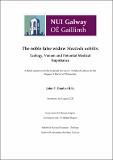| dc.description.abstract | The noble false widow spider Steatoda nobilis (Thorell, 1875) has expanded its range globally in recent years and may represent a potential threat to native ecosystems and public health. Our data shows that S. nobilis is an extremely prolific, resilient species with distinct synanthropic affinities. In Ireland, this species appears to be currently restricted to urbanised habitat across at least 17 counties with the largest populations observed along the eastern and southern coastal urban corridors. While our findings suggest S. nobilis is currently absent from natural, undisturbed habitats such as woodlands, bogs, and grassland, distribution trends in other parts of the world indicate that eventually this species may invade natural habitats. S. nobilis is a generalist predator capable of preying on a diverse range of prey including invertebrates and small reptiles. In addition to its comparatively fast reproductive rate, long life span and year-round activity, S. nobilis appears capable of having a detrimental impact on native species.
With a preference for synanthropic habitats in temperate climates, this has led to an increase in human encounters resulting in bites with medically important outcomes. S. nobilis envenomation symptoms have similarities to Latrodectus and using a combination of transcriptomic and proteomic cutting-edge approaches we have characterised the venom composition of S. nobilis. We demonstrate that two-thirds of venom toxins produced by S. nobilis are also present in Latrodectus, including α-latrotoxins, 𝛿-latroinsectotoxins and α-latrocrustotoxins. Also present are the enzymatic machinery that presumably facilitate the spread of venom into the prey (metallo and serine proteases, chitinases). In high concentrations, α-latrotoxin can cause localised cell death and is potentially potentiated by the presence of enzymes. This may induce necrosis and provide substrate that could facilitate bacterial virulence. Indeed, the medical assessment of 20 case reports of confirmed bites by S. nobilis demonstrate that the venom is highly active and that symptom presentation can overlap with those caused by Latrodectus. The most common symptoms are prolonged moderate to intense pain, erythema, swelling and pruritus. Others include radiating and debilitating pain, tremors, fatigue, nausea, local sweating, a sensation of heat, tenderness, piloerection, inflammation, irritation, raised skin, lump/pimple and blister formation, and paraesthesia around the bite site, muscle contractions in the affected area, reduced mobility in the affected limb, vasodilation of the capillaries, and necrosis. Other pathologies can include vectored bacterial infections including cellulitis and dermatitis. We conclude from this extensive study that steatodism is a rare, but potentially severe, clinical syndrome when caused by the noble false widow spider S. nobilis.
Irrespective of the media sensationalism, the continued rise of S. nobilis may legitimately present as an emerging public health issue, with potential serious outcomes for some victims. In addition to having potential invasiveness, this species deserves close monitoring and research by both the scientific and medical community and updated public awareness by public health authorities. | en_IE |


